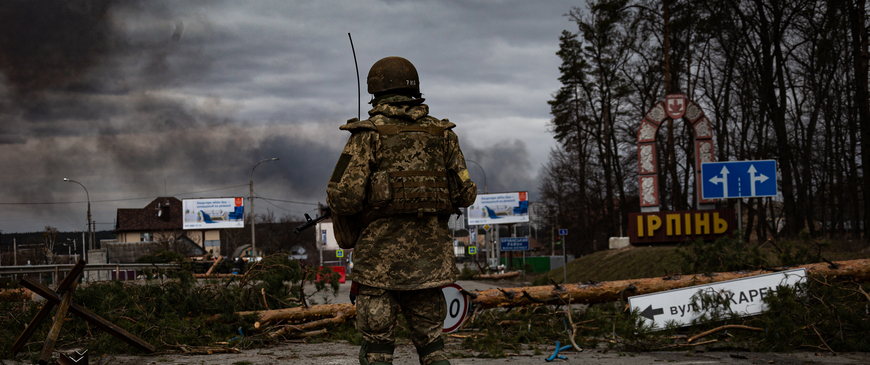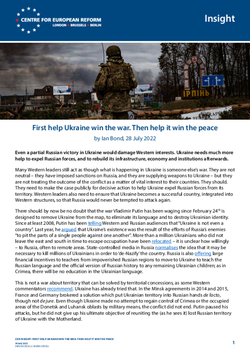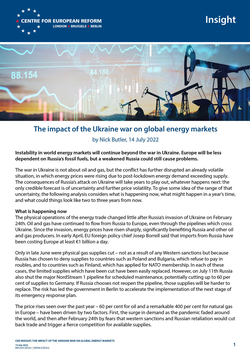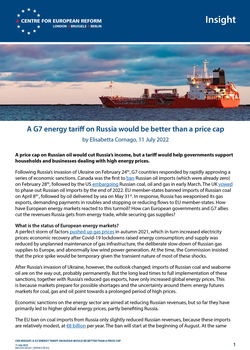
First help Ukraine win the war. Then help it win the peace
Even a partial Russian victory in Ukraine would damage Western interests. Ukraine needs much more help to expel Russian forces, and to rebuild its infrastructure, economy and institutions afterwards.
Many Western leaders still act as though what is happening in Ukraine is someone else’s war. They are not neutral – they have imposed sanctions on Russia, and they are supplying weapons to Ukraine – but they are not treating the outcome of the conflict as a matter of vital interest to their countries. They should. They need to make the case publicly for decisive action to help Ukraine expel Russian forces from its territory. Western leaders also need to ensure that Ukraine becomes a successful country, integrated into Western structures, so that Russia would never be tempted to attack again.
There should by now be no doubt that the war Vladimir Putin has been waging since February 24th is designed to remove Ukraine from the map, to eliminate its language and to destroy Ukrainian identity. Since at least 2008, Putin has been telling Western and Russian audiences that “Ukraine is not even a country”. Last year, he argued that Ukraine’s existence was the result of the efforts of Russia’s enemies “to pit the parts of a single people against one another”. More than a million Ukrainians who did not leave the east and south in time to escape occupation have been relocated – it is unclear how willingly – to Russia, often to remote areas. State-controlled media in Russia normalises the idea that it may be necessary to kill millions of Ukrainians in order to ‘de-Nazify’ the country. Russia is also offering large financial incentives to teachers from impoverished Russian regions to move to Ukraine to teach theRussian language and the official version of Russian history to any remaining Ukrainian children; as in Crimea, there will be no education in the Ukrainian language.
This is not a war about territory that can be solved by territorial concessions, as some Western commentators recommend. Ukraine has already tried that. In the Minsk agreements in 2014 and 2015, France and Germany brokered a solution which put Ukrainian territory into Russian hands de facto, though not de jure. Even though Ukraine made no attempt to regain control of Crimea or the occupied areas of the Donetsk and Luhansk oblasts by military means, the conflict did not end. Putin paused his attacks, but he did not give up his ultimate objective of reuniting the (as he sees it) lost Russian territory of Ukraine with the Motherland.
This is not a war about territory that can be solved by territorial concessions, as some Western commentators recommend.
Some Western governments are still acting as though making concessions to Putin at the expense of Ukraine would satisfy him and enable them to avoid difficult decisions about energy supplies, economic disruption and defence. Rather than talking about what it would take for Ukraine to inflict a decisive defeat on Russia and force it to leave all Ukrainian territory, Western officials talk privately in terms that suggest that their aim is limited to enabling Ukrainian forces to threaten to counter-attack in southern and eastern Ukraine. They hope that that would give the Russians an incentive to come to the negotiating table and perhaps agree to return to the front lines of February 23rd 2022.
Such an outcome would – again – offer Putin the chance to pause, put right some of the problems with the Russian military that this campaign has exposed, and then attack again. In a recent speech in which he likened himself to Peter the Great, ‘returning’ lands around the Baltic Sea to Russian control, Putin reminded his audience that it took Peter 21 years of fighting to defeat Sweden – a clear sign that he is prepared for the long haul, and a warning that his ambitions may go beyond Ukraine, to other territory, such as the Baltic states, that he regards as historically Russian.
Whatever advice it receives from Western politicians and commentators, only Ukraine can decide on its war aims. Polling evidence shows that Ukrainian voters overwhelmingly support expelling Russia from all of Ukraine, including Crimea. Ukrainians can see, more clearly than Western leaders, that any ceasefire based on making concessions to Russia – whether in terms of territory, Ukrainian neutrality, special rights for Russian-speakers in Ukraine or the lifting of some Western sanctions against Russia – will only increase the chance of renewed Russian aggression in a year or two. So with or without more Western weapons, Ukrainians are likely to fight on – and in practice, it is likely that at least some Central and Northern European countries would continue to supply Ukraine with arms, even if the US and others did not.
Instead of entertaining arguments for offering Putin an off-ramp or ending the war before sanctions lead to a recession, Western leaders need to explain to their voters that any outcome that leaves Putin feeling that he has gained something by military aggression and economic blackmail will quickly rebound against the West. Putin will continue to threaten and destabilise his neighbours (potentially including NATO members like the Baltic states, if he senses a lack of resolve to defend them). As long as major European powers are consumers of Russian energy, Putin will use the leverage that provides in an effort to divide and rule. Putin knows also that by manufacturing a refugee crisis, directly (by driving Ukrainians westwards) or indirectly (by creating a food crisis in the EU’s southern neighbourhood) he will put pressure on European leaders to do deals with him, or at the very least will distract their attention away from Ukraine itself. The West needs to summon up the determination to help Ukraine win a decisive victory that ensures that Russia is in no position to attack either Ukraine itself or any other neighbouring country for many years to come. That will involve both weakening Russia and strengthening Ukraine.
Putin will continue to threaten and destabilise his neighbours (potentially including NATO members like the Baltic states, if he senses a lack of resolve to defend them).
To weaken Russia, the West needs to limit Russia’s income from exporting fossil fuels, both by cutting its own imports of Russian fossil fuels as quickly as possible and by measures such as price caps or tariffs. The West also needs to tighten restrictions on Russian imports of Western components and technology further. As in the Soviet era, the West will not be able to stop leakage entirely, but it will be able to limit Russia’s ability to produce advanced weapons systems. As goods containing Western technology become unavailable, it will also make the impact of the war on everyday life more visible to Russian consumers.
To strengthen Ukraine, the West needs both to accelerate the delivery of advanced weapons and to take a more radical approach to helping Ukraine build armed forces able to defeat Russia on the battlefield. In 1940, before Pearl Harbor triggered its entry into the war, President Franklin Roosevelt called the US “the great arsenal of democracy” – protecting its own national security by providing armaments to its democratic allies in Europe. Now the US and its European allies have to fulfil the same role by arming Ukraine.
Months have been wasted, but little by little the West is overcoming its inhibitions: it has moved from supplying surplus ex-Soviet kit still in the inventories of some Central European NATO members to providing modern artillery systems that are enabling Ukraine to strike ammunition stores and command and control in the Russian rear. US officials have said recently that Ukraine is likely to get Western fighters and perhaps also ground attack aircraft. Giving Ukraine the capability to strike Russian forces in and from the air would be an important step towards military success.
Qualitative improvements in the equipment available to Ukraine are helping to offset its quantitative inferiority to Russian forces, but not enough to ensure victory. Ukraine is using newly-supplied long-range artillery to good effect, but it cannot afford to lose any of it. Apart from any concerns about ‘provoking’ Russia, the problem is that few Western armies have many weapons or munitions to spare, and some have already sent a significant portion of their stocks to Ukraine. In the early stages of the war, when the main need was for anti-tank weapons, the UK sent Ukraine more than a quarter of its stock of NLAW man-portable anti-tank missiles. Though Western governments and industry are making efforts to speed up production to replace what has been supplied to Ukraine, it will take them some time to do so: Lockheed Martin has estimated that it could take up to two years to increase the annual production of Javelin anti-tank weapons from 2,100 to 4,000.
Until production can be increased, most Western governments can afford to accept a slightly higher level of risk, and should transfer more of their stocks to Ukraine. The more the Ukrainians have, the more Russia will be tied down there; and it is unlikely that Western European forces will need their heavy weapons systems to fight anyone else in the short term. The US, having to insure against wider global risks, might feel that it has to hold more in its inventory, but it could probably also recalibrate and supply more without putting its own security at significantly greater risk.
The US government should also reconsider the limitations it has imposed on how Ukraine may use the systems supplied. When Russia is launching strikes against Ukraine from locations deep within Russian territory, and when key Russian logistic hubs are inside Russia, it makes no sense to prohibit Ukraine from targeting Russian territory, for fear that such strikes might lead to escalation. Occasional Ukrainian strikes on Russian soil using non-Western weapons systems have not led to any Russian escalation. Recent expert analysis of Putin’s decisions when confronted by the West elsewhere – in Syria and Libya, for example – shows that the idea that he will always escalate in response is wrong. Jake Sullivan, the US National Security Adviser, said recently that Joe Biden will not supply Ukraine with missiles with a 300-kilometre range for fear of ending up in a third world war. It is extremely unlikely, however, that Putin would decide to attack NATO territory in order to retaliate for anything Ukraine does with Western weapons: to do so would risk massive retaliation from NATO, disproportionate to any advantage that Putin could hope to gain. For Ukraine, on the other hand, the ability to put at risk Russian supply lines and command locations at any range from the front line to far in the rear would make it much harder for Russia to keep fighting on Ukrainian territory; and if Russian forces were forced to withdraw, Ukraine would be able to deter future cross-border strikes.
The US government should reconsider the limitations it has imposed on how Ukraine may use the weapons systems supplied.
It will not be easy for Ukraine to expel Russia from the whole of the country, even with Western help. Regaining control of Crimea would be the most difficult task of all. Practically, it is hard to access from the north and therefore militarily challenging. Politically, it is already (from Putin’s perspective) Russian territory, and because of the strategic significance of Sevastopol as a naval base, he might treat even a conventional attack on Crimea as something that would (in the words of Russia’s 2020 nuclear doctrine) put “the very existence of the state in jeopardy” and justify nuclear retaliation. Recent analysis by experts from the Royal United Services Institute suggested that Russian nuclear weapons were “unlikely to be used in Ukraine, except in the unlikely scenario that Russian forces are routed to the point that Ukraine can retake Crimea”. Ukraine and its Western partners would have to be alert to any signs of the Kremlin moving from rhetorical threats to use nuclear weapons to practical preparations for their use.
If winning the war will be hard for Ukraine, winning the peace will be even harder. Even if Russian forces are pushed back into Russia, it will be hard to give the Ukrainian population and potential investors confidence that Ukraine is permanently secure, and that Russia will not attack again in a few years’ time. The most important thing that the West can do once the fighting stops, therefore, is to provide Ukraine with credible, binding security guarantees of assistance in case of attack. Ideally, Ukraine should be invited to join NATO as soon as possible, making good on the promise NATO leaders made in 2008 that Ukraine would become a member of the alliance. At that time, France and Germany (in particular) thought that offering Georgia and Ukraine a specific process and timeline leading to membership would provoke Russia; the subsequent history showed that leaving the question open only encouraged Russia to attack both countries. Bringing Ukraine under NATO’s umbrella would automatically increase the likelihood of collective military action against Russia if it tried to renew its offensive against Ukraine at any point; for the first time since Ukraine gained its independence, it would benefit from a credible deterrent against Russian aggression. If NATO membership were still viewed by some allies as a step too far, then a ‘coalition of the willing’ should offer bilateral commitments to defend Ukraine, and station troops as far east as possible in the country, on the model of NATO’s enhanced forward presence in the Baltic States and Poland.
With a security guarantee in place, Ukraine and its Western partners could start rebuilding the country. Werner Hoyer, the president of the European Investment Bank, has estimated that reconstruction might cost €1 trillion. As Russia relentlessly bombards Ukrainian housing, schools, hospitals, factories and infrastructure, that cost is rising.
No European country has suffered destruction on this scale since World War Two. The reconstruction effort will have to be on a corresponding scale. Most of the money will not come from Ukraine, at least initially, but from its Western partners. Even if they can find legal ways to expropriate currently frozen Russian assets, including the central bank’s foreign reserves, they will still have to find hundreds of billions of euros more. EU countries will have to make difficult decisions about lending large sums to Ukraine that might never be paid back, and probably issuing more debt themselves to fund the rebuilding. But the West cannot afford to leave Ukraine in ruins: if it does, the population will continue to emigrate; the economy will continue to contract; Ukrainian food production will not recover; and Ukraine will become a state permanently on the verge of failure. Putin will be able to point to Ukraine as an example of what happens to the West’s friends and those who try to resist Russia.
No European country has suffered destruction on this scale since World War Two. The reconstruction effort will have to be on a corresponding scale.
To make a success of reconstruction, however, Ukraine and its Western partners will have to overcome the country’s notorious corruption. Afghanistan offers a cautionary tale of how enormous sums of money intended for reconstruction can be diverted to enrich well-connected individuals and groups and entrench their political power.
When it made Ukraine a candidate for membership in June, the EU set out seven steps for Ukraine to take as preconditions for the launch of accession negotiations; most of them relate to judicial reform, the fight against corruption and reducing the influence of oligarchs. The EU and Western governments will have to stay closely engaged in Ukraine’s efforts to fulfil these conditions, perhaps through twinning arrangements or embedding personnel in Ukrainian agencies.
Ukraine’s president, Volodymyr Zelenskyy, has proved himself a charismatic and courageous war leader; but his handling of personnel decisions has been less satisfactory. Western experts worry, for example, that members of the president’s circle may hinder much-needed reforms of the Prosecutor General’s Office and the work of the (separate) Special Anti-Corruption Prosecutor’s Office. Ukraine’s vigorous civil society has been good at getting rid of bad presidents, in 2004 and 2014, but less good at ensuring that their successors build sustainable institutions and consolidate the rule of law. The West will need to work alongside Ukrainians of goodwill to ensure a better outcome this time; Russia will certainly be doing what it can to help the bad actors.
Ukrainians have shown immense courage, not only in the last five months, but in the previous eight years. They have sacrificed more than any other nation for the right to be part of the European and Euro-Atlantic family. If Ukraine can go on after this war to become a secure, prosperous and democratic member of the EU and NATO, that will transform Eastern Europe’s chances of shaking off the Soviet legacy. If the West allows Ukraine to fail in the war or go back to being a corrupt and impoverished post-Soviet state afterwards, then Russian revanchism will continue to threaten Europe. Former Swedish Prime Minister Carl Bildt told the European Council on Foreign Relations in June 2022: “Europe is at war”. He was right. It is a war Ukraine and the West must win.
Ian Bond is director of foreign policy at the Centre for European Reform.




Add new comment